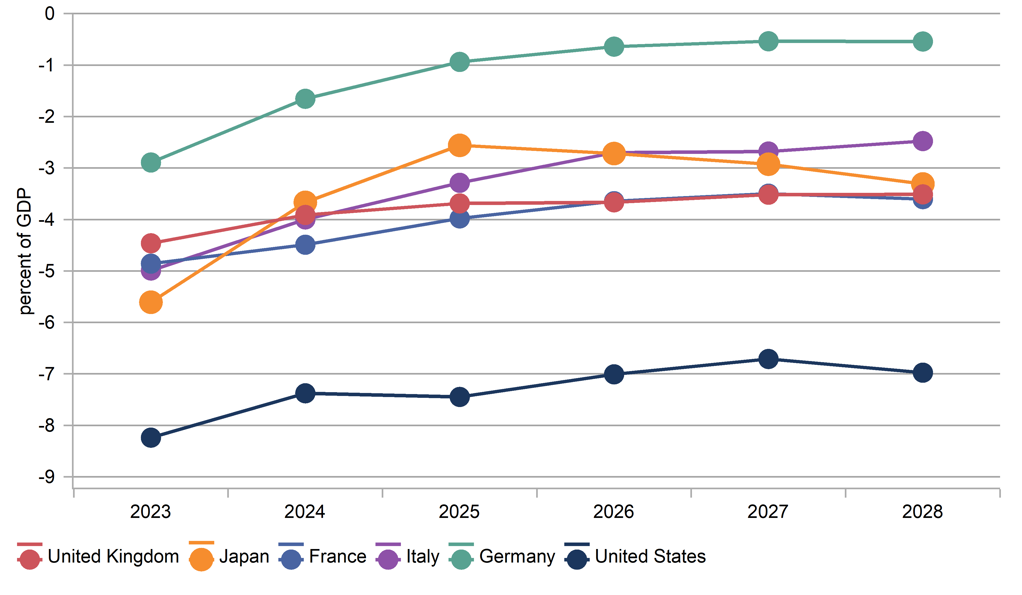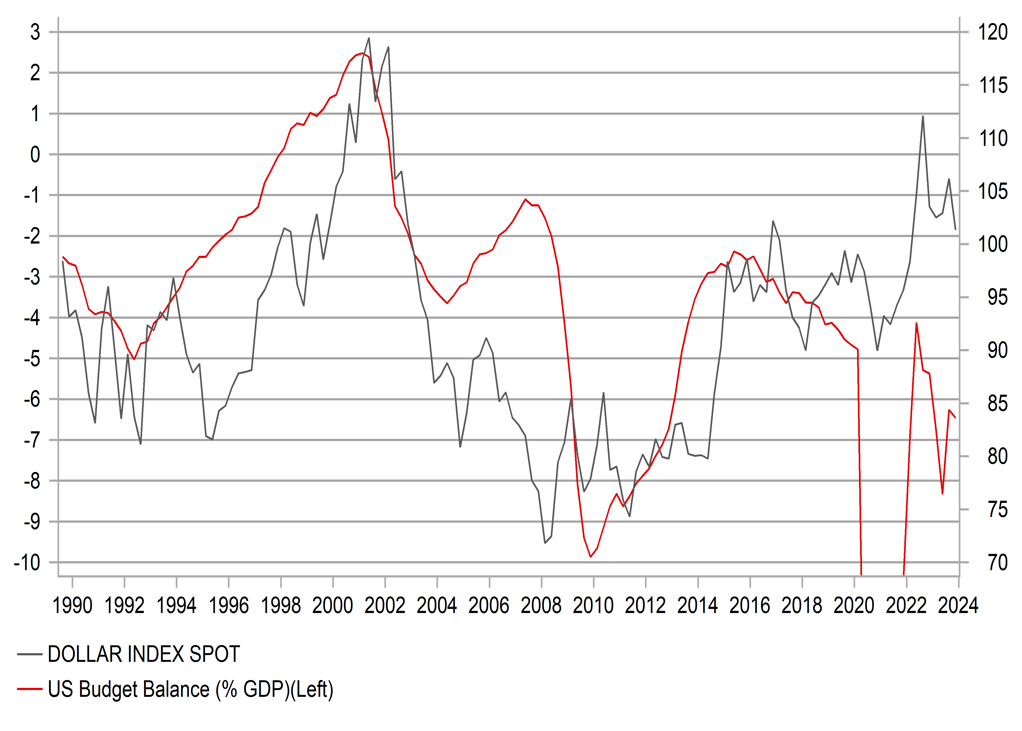“US exceptionalism” doesn’t tally with its fiscal deficits
USD: Don’t assume US “exceptionalism” will persist
Very narrow trading ranges and very low volatility in FX markets continue with little in the way of market moving developments to spark bigger moves (bar NZD – see below). We are approaching month-end and that in itself could be the catalyst for a move with most financial news stories suggesting a bias for the US dollar to weaken. The US dollar did bounce briefly in the London afternoon yesterday but quickly reversed course. Weaker than expected consumer confidence data certainly adds credence to the view after the weak retail sales data for January that the US consumer will slow and ultimately result in a slower rate of Q/Q growth. The current Bloomberg consensus for Q1 real GDP of 2.0% Q/Q SAAR looks a little on the high side for sure.
In yesterday’s quiet trading session we came across the Bloomberg article on “US exceptionalism” that will help the US dollar “ride the wave” and remain strong. We certainly couldn’t disagree with elements of the article but would question the conclusions of sustained US dollar strength. We will be releasing our FX Outlook on Friday and without divulging specifics on forecasts we can certainly say now our forecasts won’t change very much which implies roughly US dollar depreciation of about 5% from now through to year-end.
US growth certainly has been exceptional relative to most other major developed economies and that was reflected in the US dollar advancing in September 2022 to the highest level since October 2002. From the post-pandemic low, the Fed’s USD Advance Economies Index surged 20%. From the 2011 low, the US dollar advanced by 49% - it was the second largest (1980-85 bull run was 54%) and the longest bull-run in the floating exchange rate era. We think it unlikely that the 2022 high will be broken and the next medium-term to long-term move for the dollar will be weaker.
One aspect of US exceptionalism of late has been the hugely different energy price shocks that hit Europe far more significantly than the US given the US is an energy producer and because of Russia supply issues did not see anything like the energy price increases that Europe saw. US GDP accelerated from 1.9% in 2022 to 2.5% last year. In the euro-zone GDP slowed sharply from 3.4% in 2022 to 0.5% in 2023 while in the UK GDP growth slowed from 4.3% to just 0.1%. That divergence will now fade as natural gas prices continue to fall to new lows.
Another big part of the resilience of the US economy reflects the far larger fiscal support for the US that began pre-pandemic with the Trump tax cuts and was then followed by the CHIPS and IRA fiscal support packages for US companies and then in addition by the fiscal transfers to US consumers that resulted in excess savings reaching nearly 10% of GDP. The US budget deficit in 2021 (IMF) was still elevated at 11.6% (after 14.0% in 2020) which is in sharp contrast to the euro-zone 2021 deficit of 5.3% and 8.3% in the UK. IMF projections going forward show an average deficit in the US of 7.1% for the next five years through to 2028. The US is borrowing growth from the future and the net consequence of that is weaker growth going forward. The euro-zone deficit/GDP average in the same period is 2.25%. In the UK it’s 3.7%.
So while the US has clear advantages when it comes to tech and when it comes to labour market flexibility it also has a big problem ahead – tackling unsustainable budget deficits that ultimately point to potentially higher levels of inflation, weaker GDP growth and a weaker US dollar.
US BUDGET DEFICITS % GDP WAY LARGER OUT TO 2028

Source: Bloomberg, Macrobond & MUFG GMR
NZD: RBNZ triggers NZD plunge
The rates curve has certainly looked out of kilter relative to the rest of G10 and in that context there was always a risk today that the RBNZ’s communications would not meet the requirements to keep the market priced for additional rate hikes. Yesterday the OIS market pricing implied a 50% chance of a 25bp rate hike at the May meeting. That has not dropped to close to zero after the RBNZ held the key policy rate at 5.50% and crucially acknowledged that risks to the inflation outlook had become more balanced. The OCR profile in its updated forecasts also revealed a slightly lower profile with the peak OCR at 5.60%, down from 5.69% previously.
The guidance on the policy outlook was also softened with the RBNZ dropping its conditional need to hike rates further if inflationary pressures were to be stronger than expected. Not the RBNZ will remain alert “heightened geopolitical and climate conditions” risks to inflation and “will act to limit spillovers into general inflation if necessary. The RBNZ added that it believed it needed to see a “sustained decline in capacity pressures” in order to bring inflation into the 1%-3% target band.
So this communication could be described as certainly a softening of a bias to tighten policy further rather than a complete removal of that bias and certainly a strong message that the current stance will be required “for a sustained period of time”. The 2yr bond yield in New Zealand has dropped 16bps and the NZD underperformance reflects a clear out of positioning on the potential for a rate cut. The latest IMM data to last Tuesday revealed Leveraged Funds’ long NZD position had reached the largest since August last year. But we remain a distance from pivoting to rate cuts and hence should mean a sustained slide in NZD from here is avoided.
US BUDGET DEFICIT % GDP VERSUS US DOLLAR (DXY)

Source: Macrobond & Bloomberg
KEY RELEASES AND EVENTS
|
Country |
GMT |
Indicator/Event |
Period |
Consensus |
Previous |
Mkt Moving |
|
IT |
09:00 |
Italian Business Confidence |
Feb |
88.7 |
88.3 |
! |
|
IT |
09:00 |
Italian Consumer Confidence |
Feb |
96.9 |
96.4 |
! |
|
EC |
10:00 |
Business and Consumer Survey |
Feb |
96.7 |
96.2 |
! |
|
EC |
10:00 |
Consumer Confidence |
Feb |
-15.5 |
-16.1 |
!! |
|
EC |
10:00 |
Services Sentiment |
Feb |
9.0 |
8.8 |
! |
|
EC |
10:00 |
Industrial Sentiment |
Feb |
-9.2 |
-9.4 |
! |
|
US |
12:00 |
MBA Mortgage Applications (WoW) |
-- |
-- |
-10.6% |
! |
|
US |
13:30 |
Core PCE Prices |
Q4 |
2.00% |
2.00% |
! |
|
US |
13:30 |
GDP (QoQ) |
Q4 |
3.3% |
4.9% |
!!! |
|
US |
13:30 |
GDP Price Index (QoQ) |
Q4 |
1.5% |
3.3% |
!! |
|
US |
13:30 |
Goods Trade Balance |
Jan |
-88.40B |
-87.89B |
!! |
|
US |
13:30 |
PCE Prices |
Q4 |
1.7% |
2.6% |
!! |
|
US |
13:30 |
Real Consumer Spending |
Q4 |
2.8% |
3.1% |
! |
|
US |
13:30 |
Retail Inventories Ex Auto |
Jan |
-- |
0.4% |
!! |
|
US |
13:30 |
Wholesale Inventories (MoM) |
-- |
0.0% |
0.4% |
! |
|
CA |
13:30 |
Current Account |
Q4 |
-1.9B |
-3.2B |
!! |
|
EC |
14:00 |
ECB McCaul Speaks |
-- |
-- |
-- |
!! |
|
UK |
15:30 |
BoE MPC Member Mann |
-- |
-- |
-- |
!!! |
|
US |
17:00 |
FOMC Member Bostic Speaks |
-- |
-- |
-- |
!! |
|
US |
17:15 |
Fed Collins Speaks |
-- |
-- |
-- |
! |
|
US |
17:45 |
FOMC Member Williams Speaks |
-- |
-- |
-- |
!!! |
Source: Bloomberg

